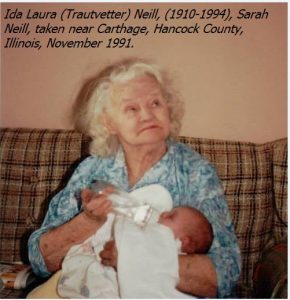 This picture of my Grandmother was used as an illustration in Genealogy Tip of the Day. As soon are it ran live, I realized that I had forgotten to indicate who was who in the photograph. Clear identification of individuals (when known) is a integral part of online distribution of photographs. I had not clearly indicated who was who.
This picture of my Grandmother was used as an illustration in Genealogy Tip of the Day. As soon are it ran live, I realized that I had forgotten to indicate who was who in the photograph. Clear identification of individuals (when known) is a integral part of online distribution of photographs. I had not clearly indicated who was who.
Then I thought about it.
There’s enough information in my caption of the photograph for someone looking at it to determine who is who.
There’s enough information in the picture to determine which individual is Ida and which individual is Sarah. Ida’s year of birth and death are indicated as is the month in which the picture was taken. Even though Sarah’s year of birth is not indicated, it should be fairly clear from the obvious age of the only individuals in the picture that one is an infant and one is not. Since the picture was taken in November of 1991, it should be “common sense” that the woman holding the child is Ida and that the child is Sarah.
How much documentation of process does one need?
Elizabeth Shown Mills partially addresses this in a slightly different context. Evidence Explained (3rd edition, 2015, Genealogical Publishing Company) mentions the “Common-Knowledge Rule” (page 44) in its discussion of the “Fundamentals of Citation.” That rule discusses what facts need to be cited and which ones do not. The date of the assassination of President Kennedy, the bombing of Pearl Harbor and similar dates and events do not need citation. They are common knowledge. My great-grandmother-in-law dying in November of 1963 and my grandparents marriage in February of 1942 need citation. Those two events are not common knowledge.
Mills even uses the phrase “common sense” when describing the “Common-Knowledge” rule, where she says “Distinguishing common knowledge from a statement that needs documentation is mostly a matter of common sense.” (page 44).
I looked to see if Mills specifically addressed “common sense” in Evidence Explained. She does not. That’s most likely because she has a great deal of common sense.
And other genealogists need to have common sense as well.
Based upon the text I included in the picture and the obvious age of the individuals involved, it should be common sense who each person is. Our documentation of sources and process need to be clear, specific, and complete, but we don’t need to drill down to the level of explaining “common sense” to people.
But if it is not common knowledge and it is not common sense–then you should be citing it and explaining it.

One response
I would write every detail because you would have to have the photo in front of you to use common sense. A lot of research I do involves other people on the internet. We do not always share a picture on the first email but rather information. As time goes by the true information is easily lost.